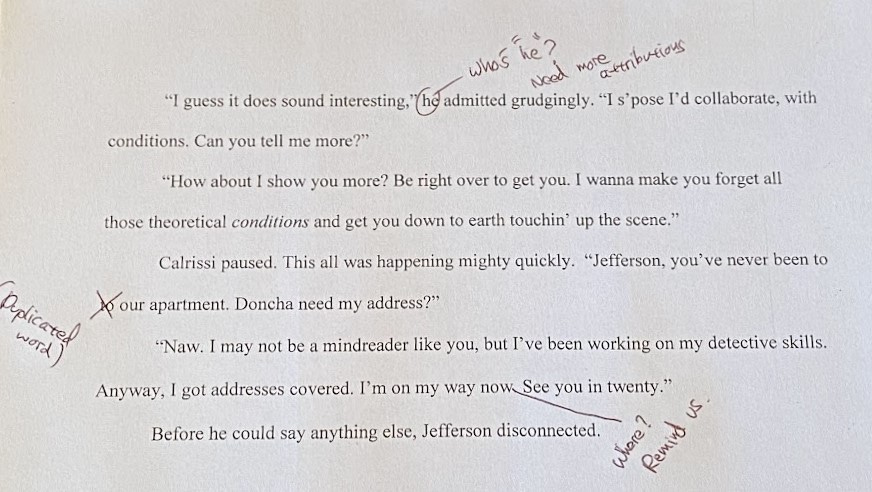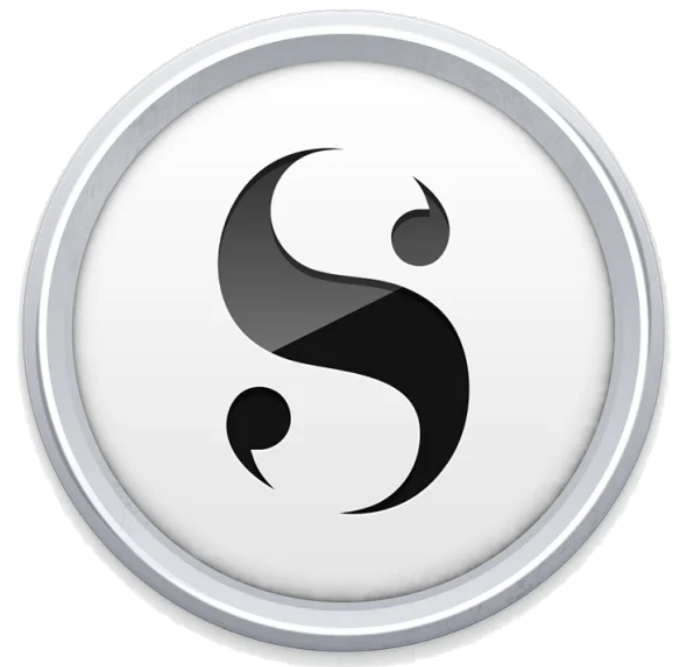How to Exchange Critiques: the Technical Part
Issue #56, Critique & Revision, 1 of 3
I got thinking about this critique-revision process during my recent five-parter which traced ideas from drafting to a finished, published tale (Writing Rhythm Issues #44-48). That example was for a short story, where I used reflection coupled with commentary from a critique group to devise the tale.
Now that we have an understanding of Beta readers and Critique Partners from Writing Rhythm Issues #52 & 53, let’s focus on the process. Here is the old-school way critiques used to be done…and as a matter of fact it’s still a valid method in critique groups.
[The sample is from “The Earthquake Liquidations,” third book in my Touch series.]
The most successful Writing Group structure I’ve ever experienced used hand markups like this. The recipe? Novel-writing members showed up in person at twice-monthly meetings armed with printed-out copies of (not more than) ten pages of their works-in-progress (WIPs). Each author read their passage aloud while the others wrote suggestions and notes on their copies. After every member offered oral comments, all copies were returned to the writer.
[See the four-part Writing Rhythm Issues #29-32) for more on writing groups.]
Outside of an in-person Writing Group, however, pen-to-paper markups are passé (or, no longer relevant). These days my own Beta and Critique Partner manuscripts are exchanged via Microsoft Word.
In case you’re not familiar, let’s do a quick rundown, complete with examples. To illustrate, I’ll use actual critique comments penned by a critique partner, who I’ll keep anonymous.
[The following excerpt comes from an early version of “The Spider Bite Murders,” the first in my Touch series.]
First, call up Word and check at the top for the Review Pane.
In the above illustration, I’ve clicked the “Review” tab, showing a drop-down menu. Click “Track Changes” (on the middle-right). After this, corrections you make on the manuscript show up in a different color. For instance:
My reader thought a comma should go after the word “beauty.” When he enabled track changes and typed a comma, the symbol was inserted in blue (I added the red circle, the better for you to see it). Note that the program also adds a small gray vertical line to the left as a second visual flag.
Back to the review pane.
This time, press “New Comment” on the left. It opens up a dialogue box to the right of the writing area into which thoughts and suggestions can be inserted, complete with a dotted line indicating the exact words to which you’re referring. For instance:
In my original, I wrote: “There seemed purpose in the crouching shape.” My reader, however, thought that sounded clunky, so he corrected it to: “There seemed to be purpose in the crouching shape.” Then he pressed “New Comment” and explained why he preferred that version.
I personally always appreciate “New Comment” additions, because they enable the CP to really dial in on their rationale behind altering the manuscript, thus giving me as the writer more food for thought for my revision.
[For these two critique examples, BTW, I took both suggestions, adding the comma in the first and changing the wording in the second.]
For more detail and guidance, see Chris Menard’s excellent video tutorial on Word’s track changes.
As mentioned in Writing Rhythm #18, Scrivener is my App of choice for novels, but Word and its Review Pane feature is more widely used.
So I compose in Scrivener and compile into Word for my critiquers, lest I fall behind the times. Which, yes, is your hint for recalling the following:
What is passé?
Action Plan:
On X (formerly Twitter), I post a new daily rhyming writing tip on which many of these issues are based. Follow—you know you want to.
Next Up:
Issue #57: How to Exchange Critiques: the Human Part, Critique & Revision, 2 of 3. See you in two weeks!
Craig


















"armed with printed-out copies of (not more than) ten pages" How about not more than one page? I'm really not kidding. One page makes it possible to focus, and the entire group to make comments on the same thing. I believe that's where "being on the same page" comes from : )